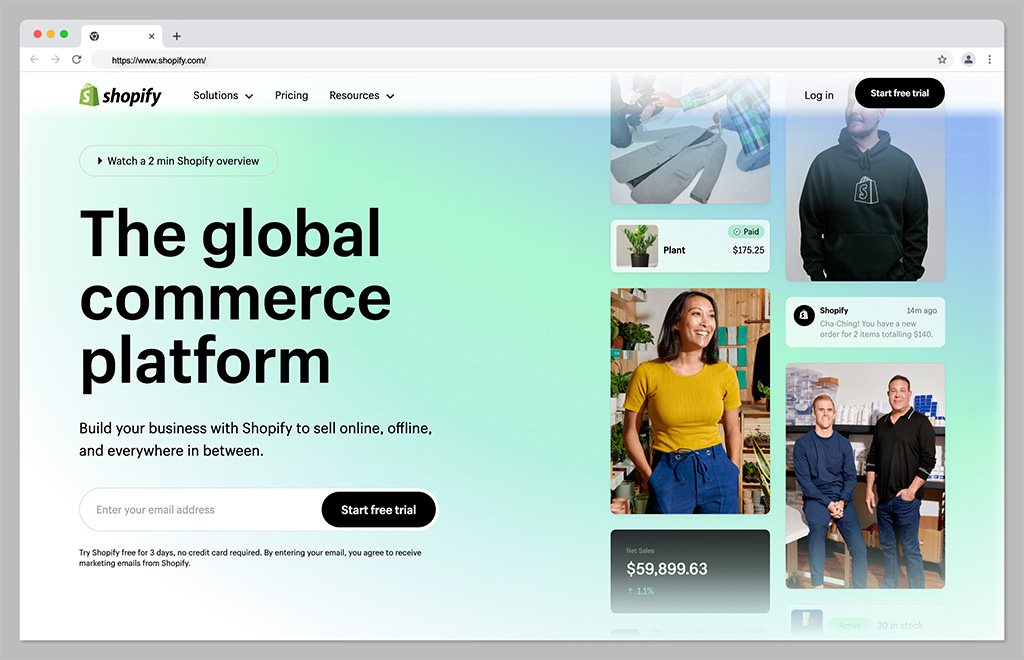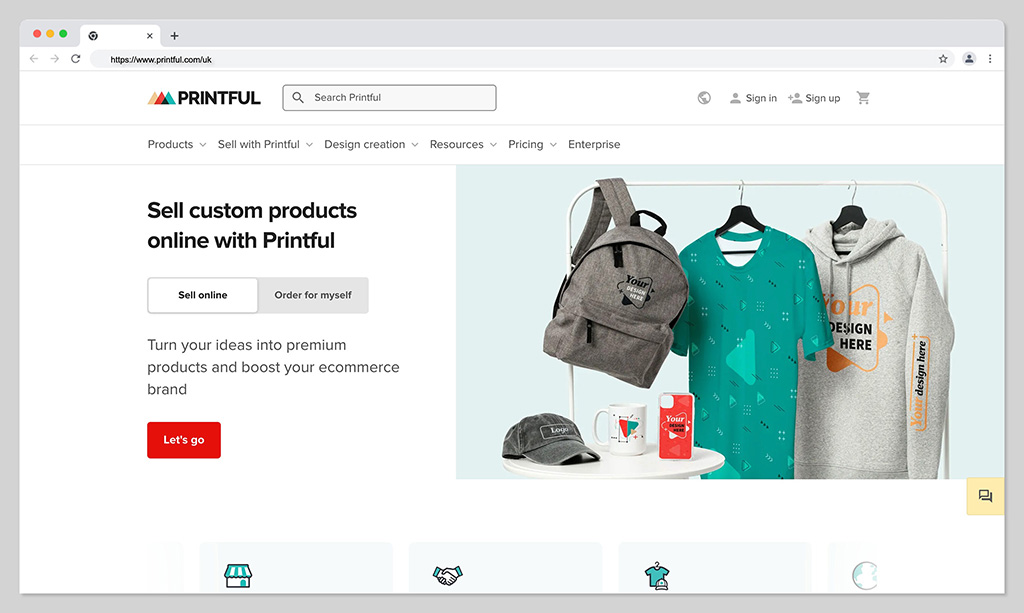Struggling to decide between Shopify vs Printful for your growing business?
Ultimately, it’s not a like-for-like comparison. While both Shopify and Printful are excellent tools for business leaders looking to develop their own online venture, they’re very different solutions.
With one option, you can build just about any kind of online store or website, create comprehensive marketing campaigns, manage finances, and access in-depth analytics. With the other, you’ll be able to create custom designs for unique print-on-demand products, and work with fulfillment partners to produce and deliver each item.
Here’s what you need to know to make the right choice.
What is Shopify?

Let’s start with the basics. Shopify is a comprehensive commerce platform, designed to help would-be entrepreneurs launch, grow, and manage a new business. The platform unifies everything you need to run your store into one easy-to-use platform.
With Shopify, you can build and customize your own online store, using simple templates and straightforward editing tools. You can also leverage tools to sell both online and offline at the same time, connecting your store to a POS system, and retail hardware.
The cloud-hosted platform can be accessed on any device, and provides valuable back-end tools for monitoring your cash flow, managing your product listings, and even setting up shipping and delivery strategies. You can manage products, inventory, and payments in one place, access data and reports to make intelligent decisions about your business, and more.
Plus, Shopify comes with a comprehensive marketplace, where you can find add-ons to enhance the functionality of your store, whether you’re looking for email marketing tools, social media solutions, SEO support, or even a print-on-demand system like Printful.
What is Printful?

Printful is a print-on-demand and fulfillment platform. Originally launched in 2013, the solution specializes in providing business owners with the tools they need to design and create their own custom products, without having to manage logistics or production in-house.
With Printful, entrepreneurs and small business owners utilize handy design tools to add patterns, designs, logos, and other elements to white label products. After you connect the Printful platform to your online store, every time a customer makes an order, their information will be automatically transferred to the Printful team, who produce your product “on demand”.
Printful also handles all the shipping requirements for your products, ensuring items get to customers as quickly and safely as possible. While you can’t use Printful to build a store, you can connect the solution to various platforms and marketplaces, from Wix and WooCommerce, to Ebay, Amazon, and even Shopify.
What Can You Do with Shopify?
Shopify stands as one of the most popular ecommerce platforms in the market today. It allows companies to design and run just about any kind of store, or website, with endless customization options, themes, templates, and built-in tools. What’s more, thanks to Shopify’s wide range of integrations, you can even use the tool to create an omnichannel store.
Shopify is an incredibly feature-rich platform, with a huge variety of features. Here’s just some of the things you can do with the website:
- Build any kind of store or website: Shopify comes with a comprehensive website builder, complete with access to templates you can customize according to your specific needs. You can create SEO-friendly blogs, online stores with print on demand and dropshipping fulfillment centers, or omnichannel sales platforms. The solution also includes access to social media and other sales channels, such as Ebay and Etsy, so you can sell anywhere.
- Sell online and offline: As well as selling products online, customers can leverage the POS solutions from Shopify to combine their online store with an offline presence. You can sync inventory and order information across all channels, and utilize an all-in-one POS system to manage staff, shopping experiences, and track store data.
- Create a brand: With Shopify, you can create and use your own domain online, create a branded store experience, and leverage hosting all in the same place. There are even creator tools to help you design logos and other assets you might need to stand out online.
- Transaction management: Shopify comes with its own customizable checkout solution, an integrated payment management system (Shopify Payments), and even Shopify Markets, which allows you to expand your reach and sell to customers around the world through the same store. There’s even the option to leverage B2B sales options. Plus, the Shopify “Shop App” supports mobile selling too.
- Marketing: Shopify’s engagement and marketing tools provide access to SEO and blogging features, options for social media and email marketing, and a range of other tools. You can leverage automation features, audience segmentation, and even apps for creating pop-ups, landing pages, and limited time offers, discounts, and sales.
- Fulfillment: Shopify has it’s own fulfillment network in the form of the Shopify Fulfillment Network and Partner Platform, so you can work with third-party logistics partners to manage your entire supply chain. You can set up printing labels, track orders, and handle everything from a central admin environment.
- Automate: With Shopify Flow, you can create automations to ensure you connect with your audience at the right time wherever they are in their purchasing journey. You’ll find automation tools for everything from tracking inventory, to managing payments and instalment transactions. Plus, there are various tools for automated marketing
Shopify also has it’s own mobile app for managing your store on the move, plus, there are banking solutions available, such as Balance and Capital for managing cash flow. Shopify also has a range of merchandising tools to help you bundle, promote, and sell products however you choose.
If you opt for the “Plus” version of Shopify, you can take your site even further, leveraging headless commerce, advanced integrations, and unique templates for your store.
What Can You Do with Printful?
Printful is a slightly less versatile solution than Shopify, but that doesn’t make it any less appealing to online brands. While Shopify focuses on supporting all kinds of online stores and websites, Printful is focused entirely on the print-on-demand landscape. The platform comes with access to a comprehensive fulfillment management solution, a mockup generator, and tons of branding options.
With Printful, you can:
- Create custom products: Printful has more than 333 white label, high-quality POD products to choose from, ranging from t-shirts, to hoodies, stickers, leggings, and virtually any other merch you can think of. All products can be enhanced with your own designs, using DTG, embroidery, and a range of other printing methods. The mockup generator allows you to add your designs to any item quickly and easily.
- Brand your packaging: Not only can you add your own branding to new products like phone cases and tote bags, but you can also brand packaging options. There are options for creating your own inside labels for apparel products, and adding custom branding to labels, package inserts, invoices, and pack-ins.
- Work with fulfillment providers: Printful aims to keep shipping costs and shipping times low, with access to a range of global fulfillment centers. You can connect with print providers all over the world, to deliver products to customers wherever they are. Printful even offers help with warehousing your products, so you can keep items in the same place.
- Sell across multiple channels: Thanks to Printful’s wide range of integration, you can sell your products on just about any platform, from Etsy to Shopify. There’s even API access available, so you can create custom automations for your print on demand business, with minimal monthly fees and very little effort.
- Automate: With Printful, you can automate your product fulfillment process, accessing easy-to-use tools to minimize the effort you’ll need to implement to run your store. Once a customer places an order, Printful handles the rest, so you can focus on building your brand with new products and marketing.
Printful also promises reliable quality with amazing materials and inks, fantastic technology, and custom branding tools, as well as eco-friendly and sustainable products. Plus, there are tons of tools and resources on the platform to help you get started.
Shopify vs Printful: Pricing
Since Shopify offers a lot more functionality than Printful overall, you can expect to pay a little more for the service. Shopify’s pricing options include:
- Shopify Basic: $39 per month for up to 1,000 inventory locations, 2 staff accounts, 44.2% discounts on shipping, store building tools, abandoned cart recovery, discount codes, gift cards, and basic reports. You also get customer segmentation features, marketing automation, unlimited contacts, shipping labels, and fraud analysis tools.
- Shopify: $105 per month for all the features of the Basic plan, with lower in-person and online transaction rates, 5 staff accounts, standard reports, international commerce, and ecommerce automations. Plus, there’s support for Shopify fulfillment.
- Shopify Advanced: $399 per month for all the features of Shopify, plus 15 staff accounts, lower payment processing rates, advanced reports, and more order fulfillment options.
Shopify also offers Shopify “Plus”, starting at $2000 per month with custom pricing for a range of advanced features, headless commerce and more. There’s also Shopify Starter, for $5 per month, for selling through social and messaging apps, and Commerce Components for some regions.
Printful, on the other hand, doesn’t charge any monthly fees for it’s service. You only pay for the cost of the items you create and your shipping fees. For a single product, shipping rates start at around $2.99, with extra fees for every product you add. Each item has it’s own pricing depending on the materials, and customizations you choose.
How to Sell with Printful on Shopify
If you’re struggling to choose between Printful vs Shopify, the good news is you don’t have to choose one or the other. Printful and Shopify can both work together, allowing you to run your own online store with print-on-demand products from Printful.
All you need to do is sign up for a Shopify account, then go to the Shopify marketplace to integrate the “Printful” app. You can then sign up for a Printful account, and click on “Add App” to link Printful to Shopify. Once you’ve installed the app, you’ll be taken to the Printful dashboard, where you can choose the products, you want to customize.
You’ll be able to use the mockup generator to add your unique designs to each item, then load your products onto your store. Every time someone makes an order for your product on Shopify, the information will be passed through to Printful, and the team will create your orders for you, before shipping them to your customers.
You can track your orders and other information directly within your Shopify site, and make changes to your product listings whenever you like. There’s also the option to order samples if you want to test the quality of your products before selling them to customers. There’s a 20% discount available for all sample orders. You can find a full guide to connecting Shopify and Printful here.
Shopify vs Printful: The Verdict
Shopify and Printful are both very different tools. Printful offers a way to create custom products and ship them to customers throughout Europe, Canada, the USA, Mexico, and Australia, with easy-to-use fulfillment services and design support. It’s one of the most popular print-on-demand services around, with an excellent product catalog to choose from.
Shopify allows you to create any kind of online business, sell quality products, and manage an offline or ecommerce store all within the same environment. With your Shopify store, you can sell to customers wherever you like, choosing from a range of products and sales options.
Ultimately, there’s no need to choose between the two. You can connect Printful to Shopify to sell your own custom products wherever you like. If you’re thinking of starting a POD business, we recommend using the two solutions together.







Comments 0 Responses